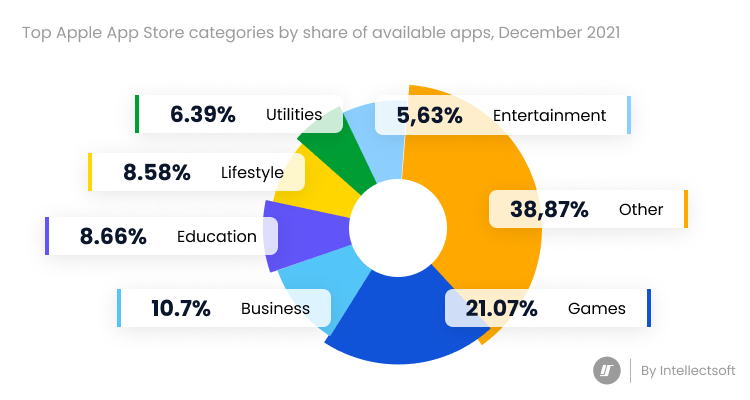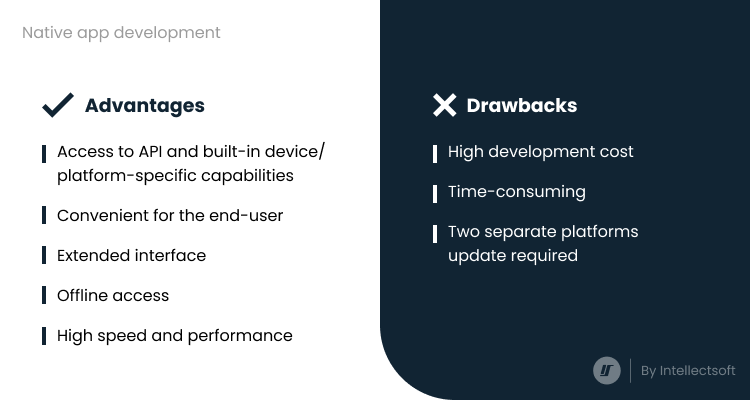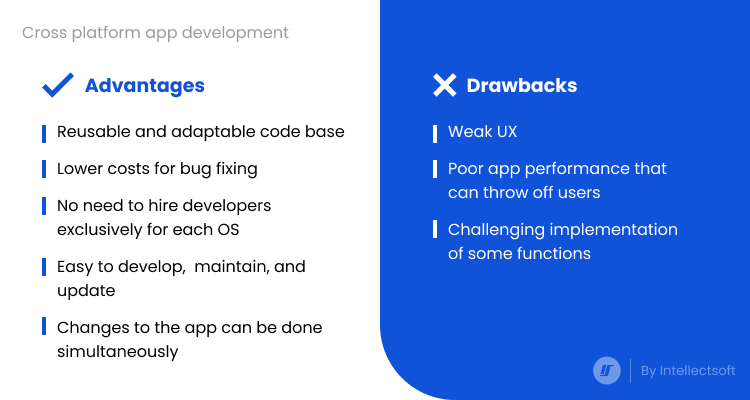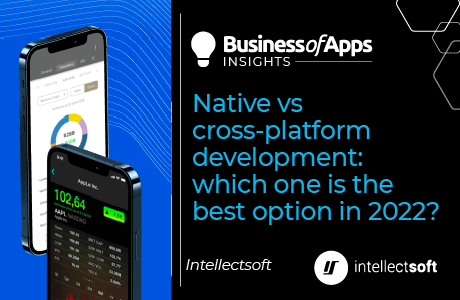According to the report, mobile app revenues reached $133 billion last year. And the strongest segment with a revenue of $89.6 billion in 2021 was mobile gaming. The research predicts that the gaming market will grow in the coming years, both in terms of revenue and player spending: by 2023, there will be 3.7 billion mobile players around the globe.
As we can see, mobile game development is one of the promising areas for investment in the world covering the largest market share — 21.07%. The business apps with a share of 10.07% are the next most popular category in the Apple Store. In the following places of this ranking, we find education and lifestyle applications.
Top Apple App Store ranking
Source: Intellectsoft
Considering such a constantly growing number of apps on both Google Play Store and Apple App Store, engineers face the issue: what approach to use in development to quickly build a top-quality product that is easy to update and maintain? Basically, the market forces programmers to choose between developing cross-platform apps and developing native applications. Let’s take a closer look at what each of these approaches means.
What is native app development?
This process of app development involves a particular set of programming languages and frameworks exclusively for a single platform. Simply put, iOS and Android applications will be built separately as the first one requires Java or Kotlin, while the second development project needs Swift and Objective-C.
If your goal is to reach the high performance, security, responsiveness, and brand new user experience of an application, then it is worth drawing attention to the native app development, which meets the requirements of a specific operating system. Though more expensive and time-consuming, this approach provides the top position on the platform’s app store and supports every feature on your mobile phone.
Pros and cons of native app development
Source: Intellectsoft
Top advantages of this development:
- Native apps provide access to API and built-in device or platform-specific capabilities.
- These apps are convenient for the end-user as they present an extended interface and can work without the Internet.
- Apps feature high speed and performance because they are built for the specific OS.
The key drawbacks:
- High development cost
- It takes a lot of development time compared to cross-platform.
- Since this process involves multiple OS, engineers have to update two separate platforms.
What is cross-platform app development?
In contrast to the previous type of app development in which developers utilize a different set of technologies for each OS, this approach refers to building mobile apps that get deployed on several platforms. According to Statista Research Department, Flutter was the number one cross-platform mobile framework choice in 2021 as 42% of software developers gave priority to it. Second place goes to React Native.
The most common programming languages are enough for programmers to code cross-platform software, and after it’s written they can reuse it again and again in new ways. Even though initially the cross-platform app development was used to create simple mobile apps and games, it is considered the most popular alternative to the above-mentioned approach these days.
Pros and cons of cross-platform app development
Source: Intellectsoft
Top advantages of this development:
- 70-80% of the code base of an application can be reused, adapting it for new platforms, which lead to significantly lower costs for bug fixing.
- With this approach, there is no need to hire developers exclusively for each OS.
- Apps are easy to develop, maintain, and update. Moreover, future changes to the app can be done simultaneously.
The key drawbacks:
- User experience (UX) is worse than in native applications.
- A poor performance of app that can throw off your users.
- The implementation of some functions will be difficult because of the various OS.
The options of app development, however, do not end there. You can also consider the hybrid app building that, as you’ve probably guessed, includes the features from several types of development. Read our recent study that talks about the key advantages and drawbacks of hybrid apps, and provides the characteristics that will help you understand when you should pick the hybrid approach as the most appropriate solution for your project.
Native vs cross-platform: what you should choose?
In order to understand which application is suitable for your project, it is very important to analyze your business: target audiences, financial resources, time availability, functionality that you need in the software, and the integration of the application with the user’s device – these are the main factors that affect your decision.
CTV Growth Guide: A must-read for performance marketers
Whether you’re looking to boost brand awareness or drive user acquisition, this guide has you covered. Learn how to leverage CTV for both brand awareness and performance-driven campaigns and get actionable insights to optimize your strategies.
Download nowThe choice in favor of a particular development approach must be made based on a variety of conditions. Consider the goals, objectives of your business, the required functionality, as well as the programming languages and technologies that your team knows. Now, let’s take a closer look at the main reasons for choosing one or another development approach:
Top reasons to choose native development:
- If you want to develop a stable, reliable application with the best performance.
- You need an application that uses location services, video, location, payments, cameras, fingerprint scanners.
- You have carte blanche to work on the project. Technically, there are no limits on how the programmers could work regarding the technology choice.
- If you have a big project and could afford to wait a few months for deployment.
- If easy and effective interaction between users and the app is essential.
Top reasons to choose cross-platform development:
- You create a demo version of the app to test a product idea and assess its validity.
- There are only front-end developers in your team with basic skills.
- You want to reduce time to market.
- You want to build apps that will run on multiple operating systems.
- Limited budget
Final thoughts
Given that the number of downloads from the Google Play and App Store has been steadily increasing, it may seem like a daunting task for businesses to find a secret formula for a successful app launch that will let them stand out. However, after clarifying the main features, pros and cons, and functionality behind each development type, determining what method is the right fit for your business and what will put you ahead of your competitors becomes much easier.
We’ve already established that not every app can be built with a cross-platform solution as well as native development isn’t always a perfect match. Therefore, when it comes to deciding what approach to use for building an app, it’s critical to understand the purpose of the software you want to create, the resources you can allocate to the project, and your target audience.

















